Cyberbullying and Gender: A Chi-Square Analysis
VerifiedAdded on 2020/04/07
|16
|3122
|183
AI Summary
This assignment examines the connection between gender and various forms of cyberbullying through chi-square analysis. Tables 3 through 6 present the findings for different types of cyberbullying (nasty text messages, prank calls, social exclusion, and image sharing). Each table includes Chi-Square values, degrees of freedom, asymptotic significance levels, and notes about expected cell counts. The data suggests a potential relationship between gender and certain cyberbullying experiences, but further analysis is needed to draw definitive conclusions.
Contribute Materials
Your contribution can guide someone’s learning journey. Share your
documents today.

CYBERBULLYING AMONG AUSTRALIAN STUDENTS
NAME:
UNIVERSITY:
DEPARTMENT:
COURSE:
REG. NUMBER:
DATE: 27/09/2017
NAME:
UNIVERSITY:
DEPARTMENT:
COURSE:
REG. NUMBER:
DATE: 27/09/2017
Secure Best Marks with AI Grader
Need help grading? Try our AI Grader for instant feedback on your assignments.
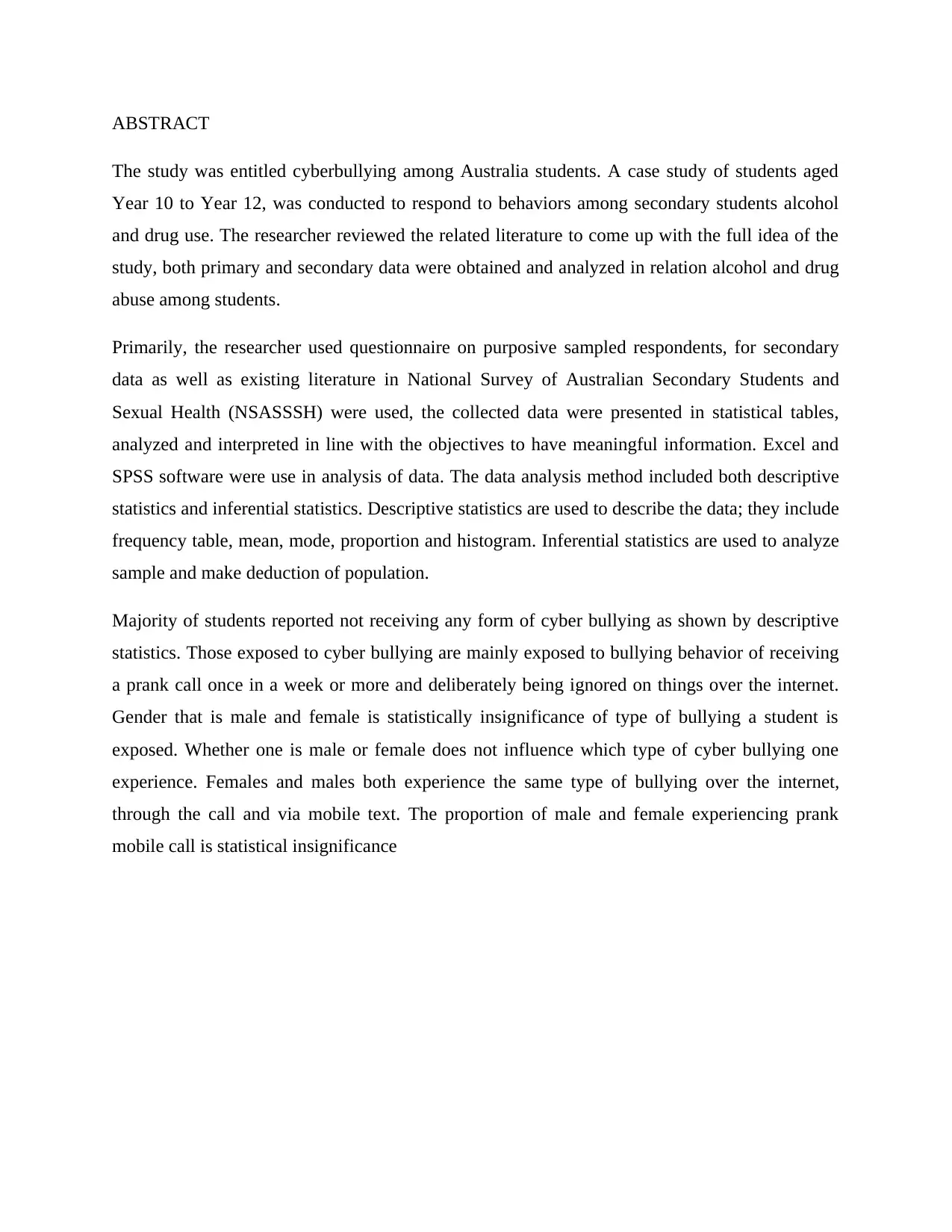
ABSTRACT
The study was entitled cyberbullying among Australia students. A case study of students aged
Year 10 to Year 12, was conducted to respond to behaviors among secondary students alcohol
and drug use. The researcher reviewed the related literature to come up with the full idea of the
study, both primary and secondary data were obtained and analyzed in relation alcohol and drug
abuse among students.
Primarily, the researcher used questionnaire on purposive sampled respondents, for secondary
data as well as existing literature in National Survey of Australian Secondary Students and
Sexual Health (NSASSSH) were used, the collected data were presented in statistical tables,
analyzed and interpreted in line with the objectives to have meaningful information. Excel and
SPSS software were use in analysis of data. The data analysis method included both descriptive
statistics and inferential statistics. Descriptive statistics are used to describe the data; they include
frequency table, mean, mode, proportion and histogram. Inferential statistics are used to analyze
sample and make deduction of population.
Majority of students reported not receiving any form of cyber bullying as shown by descriptive
statistics. Those exposed to cyber bullying are mainly exposed to bullying behavior of receiving
a prank call once in a week or more and deliberately being ignored on things over the internet.
Gender that is male and female is statistically insignificance of type of bullying a student is
exposed. Whether one is male or female does not influence which type of cyber bullying one
experience. Females and males both experience the same type of bullying over the internet,
through the call and via mobile text. The proportion of male and female experiencing prank
mobile call is statistical insignificance
The study was entitled cyberbullying among Australia students. A case study of students aged
Year 10 to Year 12, was conducted to respond to behaviors among secondary students alcohol
and drug use. The researcher reviewed the related literature to come up with the full idea of the
study, both primary and secondary data were obtained and analyzed in relation alcohol and drug
abuse among students.
Primarily, the researcher used questionnaire on purposive sampled respondents, for secondary
data as well as existing literature in National Survey of Australian Secondary Students and
Sexual Health (NSASSSH) were used, the collected data were presented in statistical tables,
analyzed and interpreted in line with the objectives to have meaningful information. Excel and
SPSS software were use in analysis of data. The data analysis method included both descriptive
statistics and inferential statistics. Descriptive statistics are used to describe the data; they include
frequency table, mean, mode, proportion and histogram. Inferential statistics are used to analyze
sample and make deduction of population.
Majority of students reported not receiving any form of cyber bullying as shown by descriptive
statistics. Those exposed to cyber bullying are mainly exposed to bullying behavior of receiving
a prank call once in a week or more and deliberately being ignored on things over the internet.
Gender that is male and female is statistically insignificance of type of bullying a student is
exposed. Whether one is male or female does not influence which type of cyber bullying one
experience. Females and males both experience the same type of bullying over the internet,
through the call and via mobile text. The proportion of male and female experiencing prank
mobile call is statistical insignificance
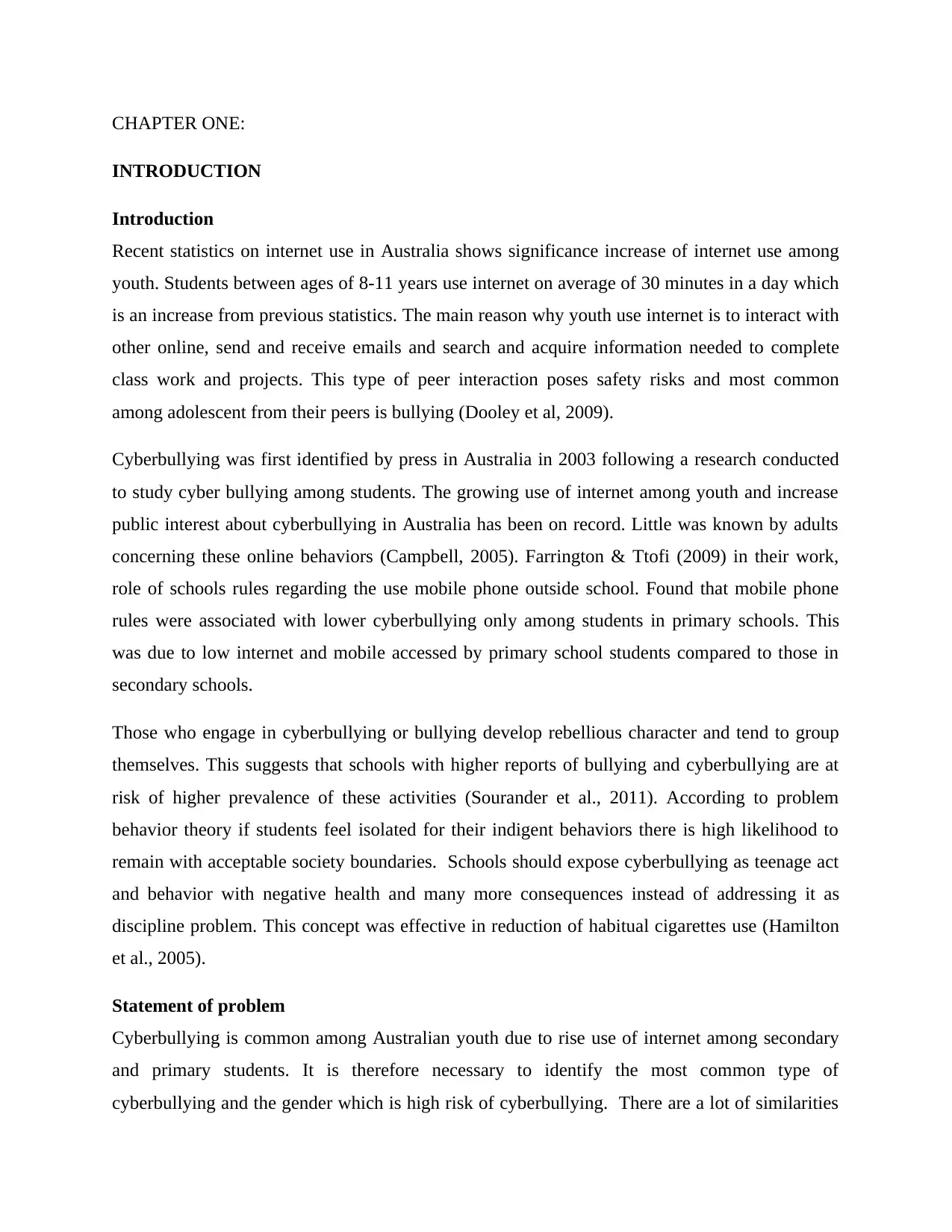
CHAPTER ONE:
INTRODUCTION
Introduction
Recent statistics on internet use in Australia shows significance increase of internet use among
youth. Students between ages of 8-11 years use internet on average of 30 minutes in a day which
is an increase from previous statistics. The main reason why youth use internet is to interact with
other online, send and receive emails and search and acquire information needed to complete
class work and projects. This type of peer interaction poses safety risks and most common
among adolescent from their peers is bullying (Dooley et al, 2009).
Cyberbullying was first identified by press in Australia in 2003 following a research conducted
to study cyber bullying among students. The growing use of internet among youth and increase
public interest about cyberbullying in Australia has been on record. Little was known by adults
concerning these online behaviors (Campbell, 2005). Farrington & Ttofi (2009) in their work,
role of schools rules regarding the use mobile phone outside school. Found that mobile phone
rules were associated with lower cyberbullying only among students in primary schools. This
was due to low internet and mobile accessed by primary school students compared to those in
secondary schools.
Those who engage in cyberbullying or bullying develop rebellious character and tend to group
themselves. This suggests that schools with higher reports of bullying and cyberbullying are at
risk of higher prevalence of these activities (Sourander et al., 2011). According to problem
behavior theory if students feel isolated for their indigent behaviors there is high likelihood to
remain with acceptable society boundaries. Schools should expose cyberbullying as teenage act
and behavior with negative health and many more consequences instead of addressing it as
discipline problem. This concept was effective in reduction of habitual cigarettes use (Hamilton
et al., 2005).
Statement of problem
Cyberbullying is common among Australian youth due to rise use of internet among secondary
and primary students. It is therefore necessary to identify the most common type of
cyberbullying and the gender which is high risk of cyberbullying. There are a lot of similarities
INTRODUCTION
Introduction
Recent statistics on internet use in Australia shows significance increase of internet use among
youth. Students between ages of 8-11 years use internet on average of 30 minutes in a day which
is an increase from previous statistics. The main reason why youth use internet is to interact with
other online, send and receive emails and search and acquire information needed to complete
class work and projects. This type of peer interaction poses safety risks and most common
among adolescent from their peers is bullying (Dooley et al, 2009).
Cyberbullying was first identified by press in Australia in 2003 following a research conducted
to study cyber bullying among students. The growing use of internet among youth and increase
public interest about cyberbullying in Australia has been on record. Little was known by adults
concerning these online behaviors (Campbell, 2005). Farrington & Ttofi (2009) in their work,
role of schools rules regarding the use mobile phone outside school. Found that mobile phone
rules were associated with lower cyberbullying only among students in primary schools. This
was due to low internet and mobile accessed by primary school students compared to those in
secondary schools.
Those who engage in cyberbullying or bullying develop rebellious character and tend to group
themselves. This suggests that schools with higher reports of bullying and cyberbullying are at
risk of higher prevalence of these activities (Sourander et al., 2011). According to problem
behavior theory if students feel isolated for their indigent behaviors there is high likelihood to
remain with acceptable society boundaries. Schools should expose cyberbullying as teenage act
and behavior with negative health and many more consequences instead of addressing it as
discipline problem. This concept was effective in reduction of habitual cigarettes use (Hamilton
et al., 2005).
Statement of problem
Cyberbullying is common among Australian youth due to rise use of internet among secondary
and primary students. It is therefore necessary to identify the most common type of
cyberbullying and the gender which is high risk of cyberbullying. There are a lot of similarities
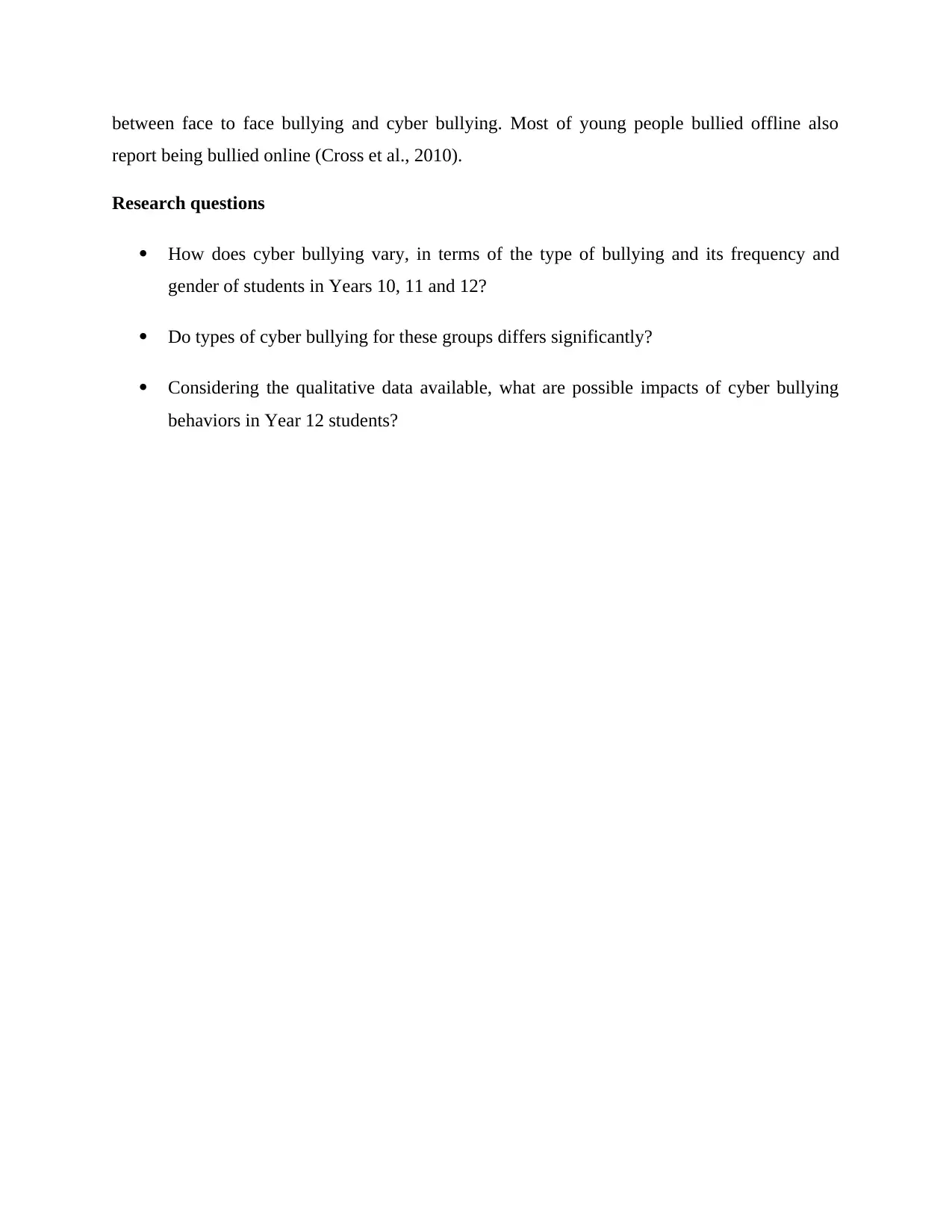
between face to face bullying and cyber bullying. Most of young people bullied offline also
report being bullied online (Cross et al., 2010).
Research questions
How does cyber bullying vary, in terms of the type of bullying and its frequency and
gender of students in Years 10, 11 and 12?
Do types of cyber bullying for these groups differs significantly?
Considering the qualitative data available, what are possible impacts of cyber bullying
behaviors in Year 12 students?
report being bullied online (Cross et al., 2010).
Research questions
How does cyber bullying vary, in terms of the type of bullying and its frequency and
gender of students in Years 10, 11 and 12?
Do types of cyber bullying for these groups differs significantly?
Considering the qualitative data available, what are possible impacts of cyber bullying
behaviors in Year 12 students?
Secure Best Marks with AI Grader
Need help grading? Try our AI Grader for instant feedback on your assignments.
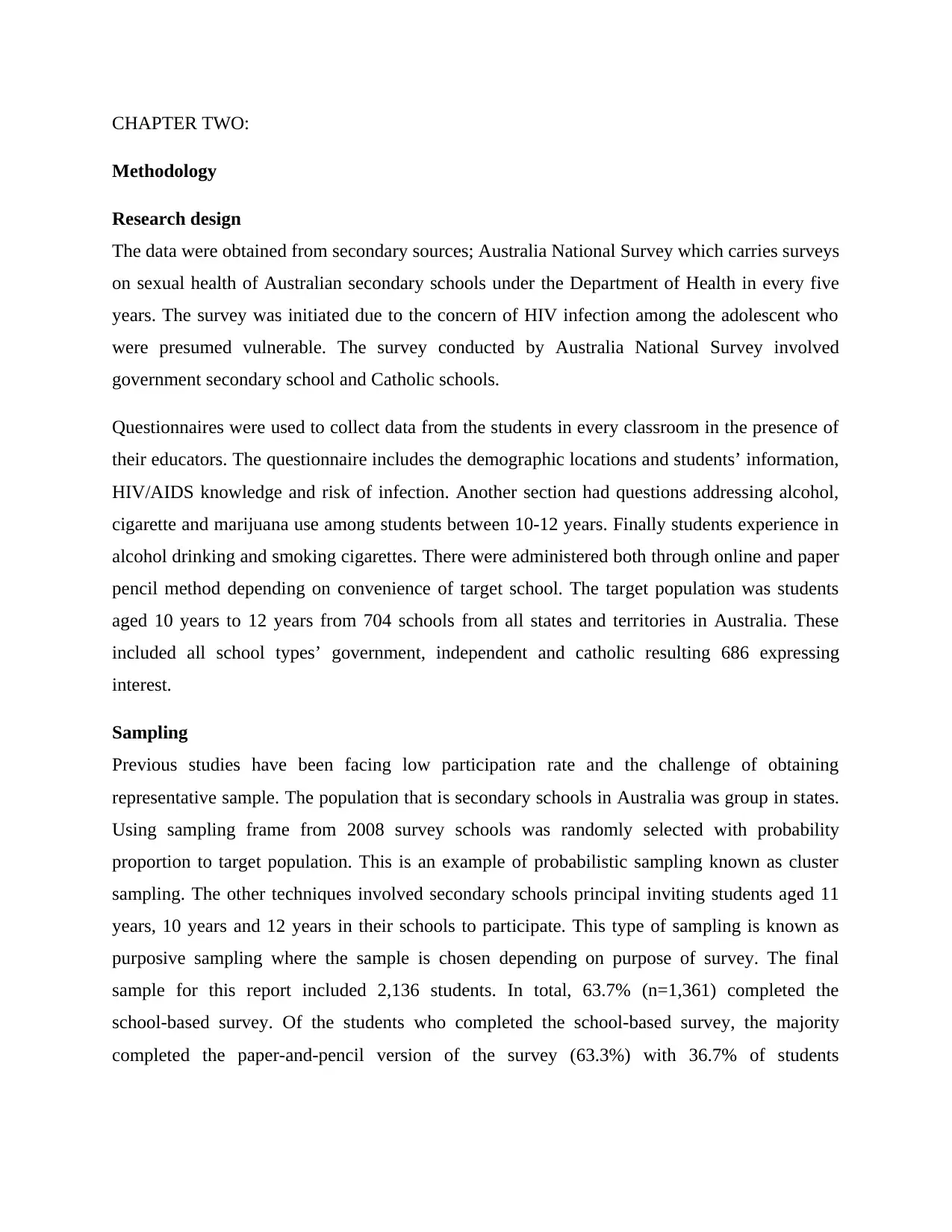
CHAPTER TWO:
Methodology
Research design
The data were obtained from secondary sources; Australia National Survey which carries surveys
on sexual health of Australian secondary schools under the Department of Health in every five
years. The survey was initiated due to the concern of HIV infection among the adolescent who
were presumed vulnerable. The survey conducted by Australia National Survey involved
government secondary school and Catholic schools.
Questionnaires were used to collect data from the students in every classroom in the presence of
their educators. The questionnaire includes the demographic locations and students’ information,
HIV/AIDS knowledge and risk of infection. Another section had questions addressing alcohol,
cigarette and marijuana use among students between 10-12 years. Finally students experience in
alcohol drinking and smoking cigarettes. There were administered both through online and paper
pencil method depending on convenience of target school. The target population was students
aged 10 years to 12 years from 704 schools from all states and territories in Australia. These
included all school types’ government, independent and catholic resulting 686 expressing
interest.
Sampling
Previous studies have been facing low participation rate and the challenge of obtaining
representative sample. The population that is secondary schools in Australia was group in states.
Using sampling frame from 2008 survey schools was randomly selected with probability
proportion to target population. This is an example of probabilistic sampling known as cluster
sampling. The other techniques involved secondary schools principal inviting students aged 11
years, 10 years and 12 years in their schools to participate. This type of sampling is known as
purposive sampling where the sample is chosen depending on purpose of survey. The final
sample for this report included 2,136 students. In total, 63.7% (n=1,361) completed the
school-based survey. Of the students who completed the school-based survey, the majority
completed the paper-and-pencil version of the survey (63.3%) with 36.7% of students
Methodology
Research design
The data were obtained from secondary sources; Australia National Survey which carries surveys
on sexual health of Australian secondary schools under the Department of Health in every five
years. The survey was initiated due to the concern of HIV infection among the adolescent who
were presumed vulnerable. The survey conducted by Australia National Survey involved
government secondary school and Catholic schools.
Questionnaires were used to collect data from the students in every classroom in the presence of
their educators. The questionnaire includes the demographic locations and students’ information,
HIV/AIDS knowledge and risk of infection. Another section had questions addressing alcohol,
cigarette and marijuana use among students between 10-12 years. Finally students experience in
alcohol drinking and smoking cigarettes. There were administered both through online and paper
pencil method depending on convenience of target school. The target population was students
aged 10 years to 12 years from 704 schools from all states and territories in Australia. These
included all school types’ government, independent and catholic resulting 686 expressing
interest.
Sampling
Previous studies have been facing low participation rate and the challenge of obtaining
representative sample. The population that is secondary schools in Australia was group in states.
Using sampling frame from 2008 survey schools was randomly selected with probability
proportion to target population. This is an example of probabilistic sampling known as cluster
sampling. The other techniques involved secondary schools principal inviting students aged 11
years, 10 years and 12 years in their schools to participate. This type of sampling is known as
purposive sampling where the sample is chosen depending on purpose of survey. The final
sample for this report included 2,136 students. In total, 63.7% (n=1,361) completed the
school-based survey. Of the students who completed the school-based survey, the majority
completed the paper-and-pencil version of the survey (63.3%) with 36.7% of students

completing the online schools based survey. The recruited online survey was completed by 775
students (36.3% of the final sample).
Descriptive data analysis method
The data obtained from Australia National Survey report on cyber bulling was entered in Excel
software and SPSS for cleaning and analysis. Descriptive and inferential statistics were used.
Descriptive statistics are used to describe the data; they include frequency table, mean, mode,
proportion and histogram.
Quantitative data analysis
Inferential statistics are used to analyze sample and make deduction of population. In our
analysis chi square test of significance was used because the data was categorical in nature. Chi-
square statistics=∑ [ ( observed−expected )2
expected ]
It is a chi-square distribution with (A-1)(B-1) degrees of freedom. Where A is number of rows
and c represent numbers of columns in the table. Rows are gender that is male and female while
columns are proportion of how frequent student is exposed to different type of cyber bullying.
Results
Descriptive statistics
The respondents were asked how often they were exposed mobile or internet communication for
last past month. With most common cyber bullying being receiving prank mobile call 10% and
being deliberately left out or ignored of issues over the internet 9%.
did not happen once or twice every few
weeks once a week or
more
0
20
40
60
80
100
I was sent threatening emails
students (36.3% of the final sample).
Descriptive data analysis method
The data obtained from Australia National Survey report on cyber bulling was entered in Excel
software and SPSS for cleaning and analysis. Descriptive and inferential statistics were used.
Descriptive statistics are used to describe the data; they include frequency table, mean, mode,
proportion and histogram.
Quantitative data analysis
Inferential statistics are used to analyze sample and make deduction of population. In our
analysis chi square test of significance was used because the data was categorical in nature. Chi-
square statistics=∑ [ ( observed−expected )2
expected ]
It is a chi-square distribution with (A-1)(B-1) degrees of freedom. Where A is number of rows
and c represent numbers of columns in the table. Rows are gender that is male and female while
columns are proportion of how frequent student is exposed to different type of cyber bullying.
Results
Descriptive statistics
The respondents were asked how often they were exposed mobile or internet communication for
last past month. With most common cyber bullying being receiving prank mobile call 10% and
being deliberately left out or ignored of issues over the internet 9%.
did not happen once or twice every few
weeks once a week or
more
0
20
40
60
80
100
I was sent threatening emails
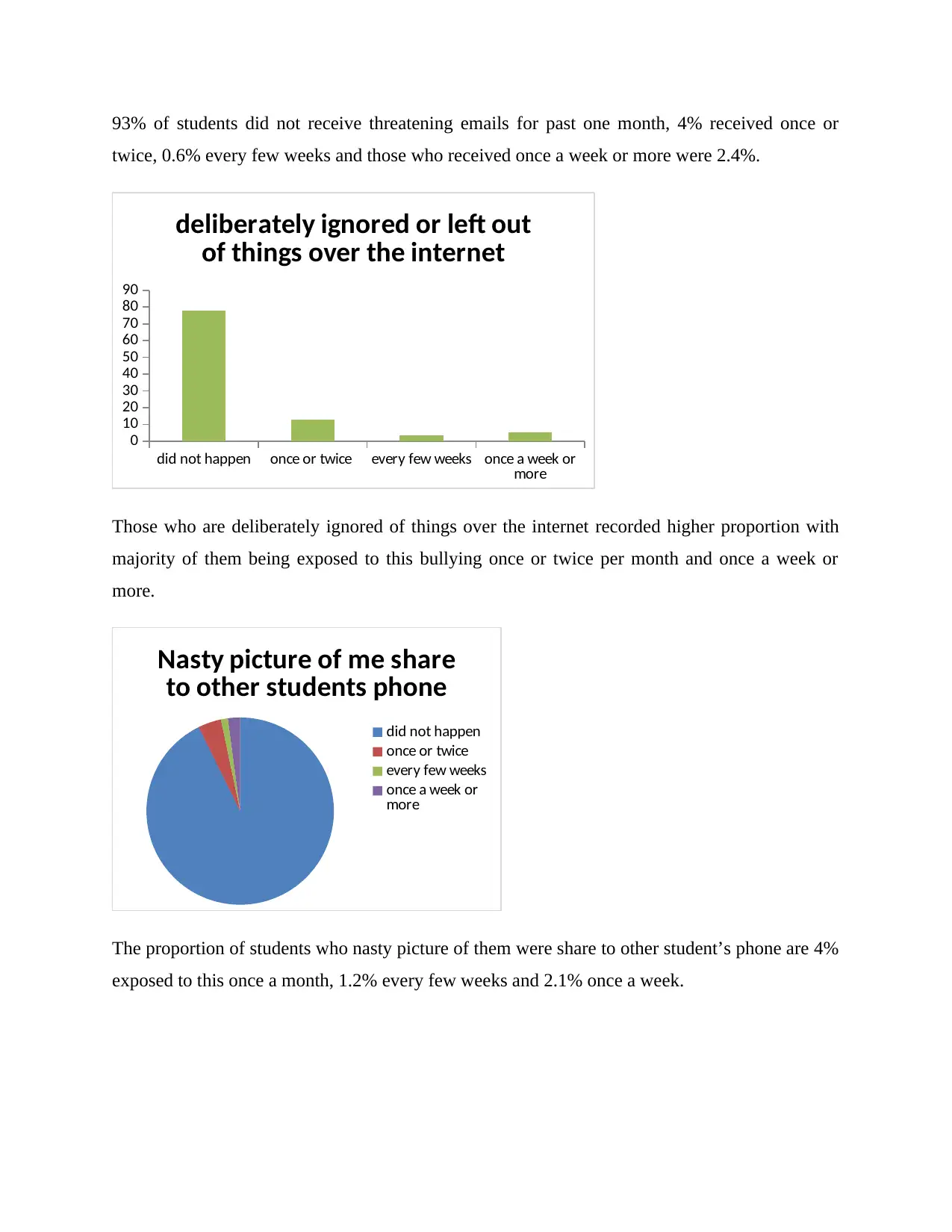
93% of students did not receive threatening emails for past one month, 4% received once or
twice, 0.6% every few weeks and those who received once a week or more were 2.4%.
did not happen once or twice every few weeks once a week or
more
0
10
20
30
40
50
60
70
80
90
deliberately ignored or left out
of things over the internet
Those who are deliberately ignored of things over the internet recorded higher proportion with
majority of them being exposed to this bullying once or twice per month and once a week or
more.
Nasty picture of me share
to other students phone
did not happen
once or twice
every few weeks
once a week or
more
The proportion of students who nasty picture of them were share to other student’s phone are 4%
exposed to this once a month, 1.2% every few weeks and 2.1% once a week.
twice, 0.6% every few weeks and those who received once a week or more were 2.4%.
did not happen once or twice every few weeks once a week or
more
0
10
20
30
40
50
60
70
80
90
deliberately ignored or left out
of things over the internet
Those who are deliberately ignored of things over the internet recorded higher proportion with
majority of them being exposed to this bullying once or twice per month and once a week or
more.
Nasty picture of me share
to other students phone
did not happen
once or twice
every few weeks
once a week or
more
The proportion of students who nasty picture of them were share to other student’s phone are 4%
exposed to this once a month, 1.2% every few weeks and 2.1% once a week.
Paraphrase This Document
Need a fresh take? Get an instant paraphrase of this document with our AI Paraphraser
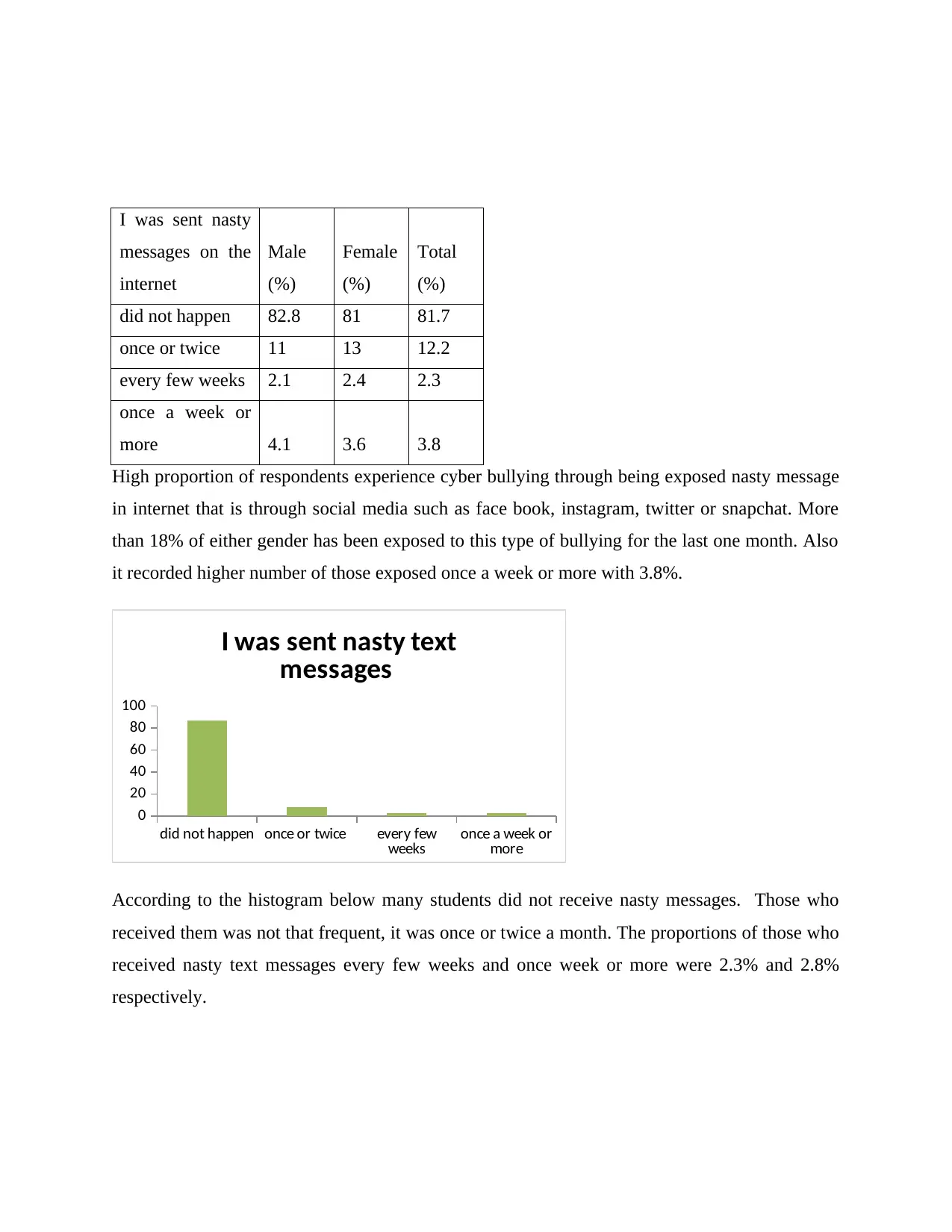
I was sent nasty
messages on the
internet
Male
(%)
Female
(%)
Total
(%)
did not happen 82.8 81 81.7
once or twice 11 13 12.2
every few weeks 2.1 2.4 2.3
once a week or
more 4.1 3.6 3.8
High proportion of respondents experience cyber bullying through being exposed nasty message
in internet that is through social media such as face book, instagram, twitter or snapchat. More
than 18% of either gender has been exposed to this type of bullying for the last one month. Also
it recorded higher number of those exposed once a week or more with 3.8%.
did not happen once or twice every few
weeks once a week or
more
0
20
40
60
80
100
I was sent nasty text
messages
According to the histogram below many students did not receive nasty messages. Those who
received them was not that frequent, it was once or twice a month. The proportions of those who
received nasty text messages every few weeks and once week or more were 2.3% and 2.8%
respectively.
messages on the
internet
Male
(%)
Female
(%)
Total
(%)
did not happen 82.8 81 81.7
once or twice 11 13 12.2
every few weeks 2.1 2.4 2.3
once a week or
more 4.1 3.6 3.8
High proportion of respondents experience cyber bullying through being exposed nasty message
in internet that is through social media such as face book, instagram, twitter or snapchat. More
than 18% of either gender has been exposed to this type of bullying for the last one month. Also
it recorded higher number of those exposed once a week or more with 3.8%.
did not happen once or twice every few
weeks once a week or
more
0
20
40
60
80
100
I was sent nasty text
messages
According to the histogram below many students did not receive nasty messages. Those who
received them was not that frequent, it was once or twice a month. The proportions of those who
received nasty text messages every few weeks and once week or more were 2.3% and 2.8%
respectively.
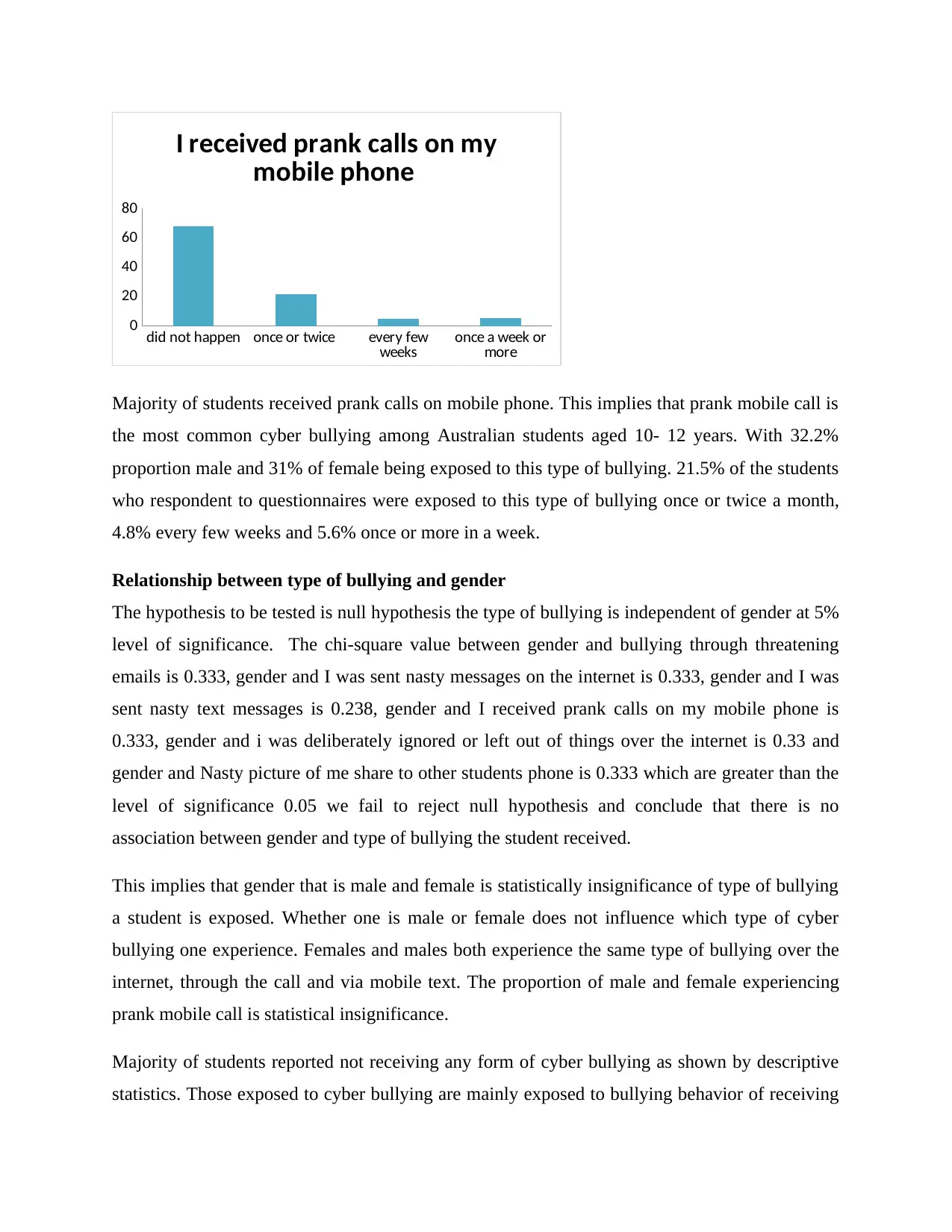
did not happen once or twice every few
weeks once a week or
more
0
20
40
60
80
I received prank calls on my
mobile phone
Majority of students received prank calls on mobile phone. This implies that prank mobile call is
the most common cyber bullying among Australian students aged 10- 12 years. With 32.2%
proportion male and 31% of female being exposed to this type of bullying. 21.5% of the students
who respondent to questionnaires were exposed to this type of bullying once or twice a month,
4.8% every few weeks and 5.6% once or more in a week.
Relationship between type of bullying and gender
The hypothesis to be tested is null hypothesis the type of bullying is independent of gender at 5%
level of significance. The chi-square value between gender and bullying through threatening
emails is 0.333, gender and I was sent nasty messages on the internet is 0.333, gender and I was
sent nasty text messages is 0.238, gender and I received prank calls on my mobile phone is
0.333, gender and i was deliberately ignored or left out of things over the internet is 0.33 and
gender and Nasty picture of me share to other students phone is 0.333 which are greater than the
level of significance 0.05 we fail to reject null hypothesis and conclude that there is no
association between gender and type of bullying the student received.
This implies that gender that is male and female is statistically insignificance of type of bullying
a student is exposed. Whether one is male or female does not influence which type of cyber
bullying one experience. Females and males both experience the same type of bullying over the
internet, through the call and via mobile text. The proportion of male and female experiencing
prank mobile call is statistical insignificance.
Majority of students reported not receiving any form of cyber bullying as shown by descriptive
statistics. Those exposed to cyber bullying are mainly exposed to bullying behavior of receiving
weeks once a week or
more
0
20
40
60
80
I received prank calls on my
mobile phone
Majority of students received prank calls on mobile phone. This implies that prank mobile call is
the most common cyber bullying among Australian students aged 10- 12 years. With 32.2%
proportion male and 31% of female being exposed to this type of bullying. 21.5% of the students
who respondent to questionnaires were exposed to this type of bullying once or twice a month,
4.8% every few weeks and 5.6% once or more in a week.
Relationship between type of bullying and gender
The hypothesis to be tested is null hypothesis the type of bullying is independent of gender at 5%
level of significance. The chi-square value between gender and bullying through threatening
emails is 0.333, gender and I was sent nasty messages on the internet is 0.333, gender and I was
sent nasty text messages is 0.238, gender and I received prank calls on my mobile phone is
0.333, gender and i was deliberately ignored or left out of things over the internet is 0.33 and
gender and Nasty picture of me share to other students phone is 0.333 which are greater than the
level of significance 0.05 we fail to reject null hypothesis and conclude that there is no
association between gender and type of bullying the student received.
This implies that gender that is male and female is statistically insignificance of type of bullying
a student is exposed. Whether one is male or female does not influence which type of cyber
bullying one experience. Females and males both experience the same type of bullying over the
internet, through the call and via mobile text. The proportion of male and female experiencing
prank mobile call is statistical insignificance.
Majority of students reported not receiving any form of cyber bullying as shown by descriptive
statistics. Those exposed to cyber bullying are mainly exposed to bullying behavior of receiving
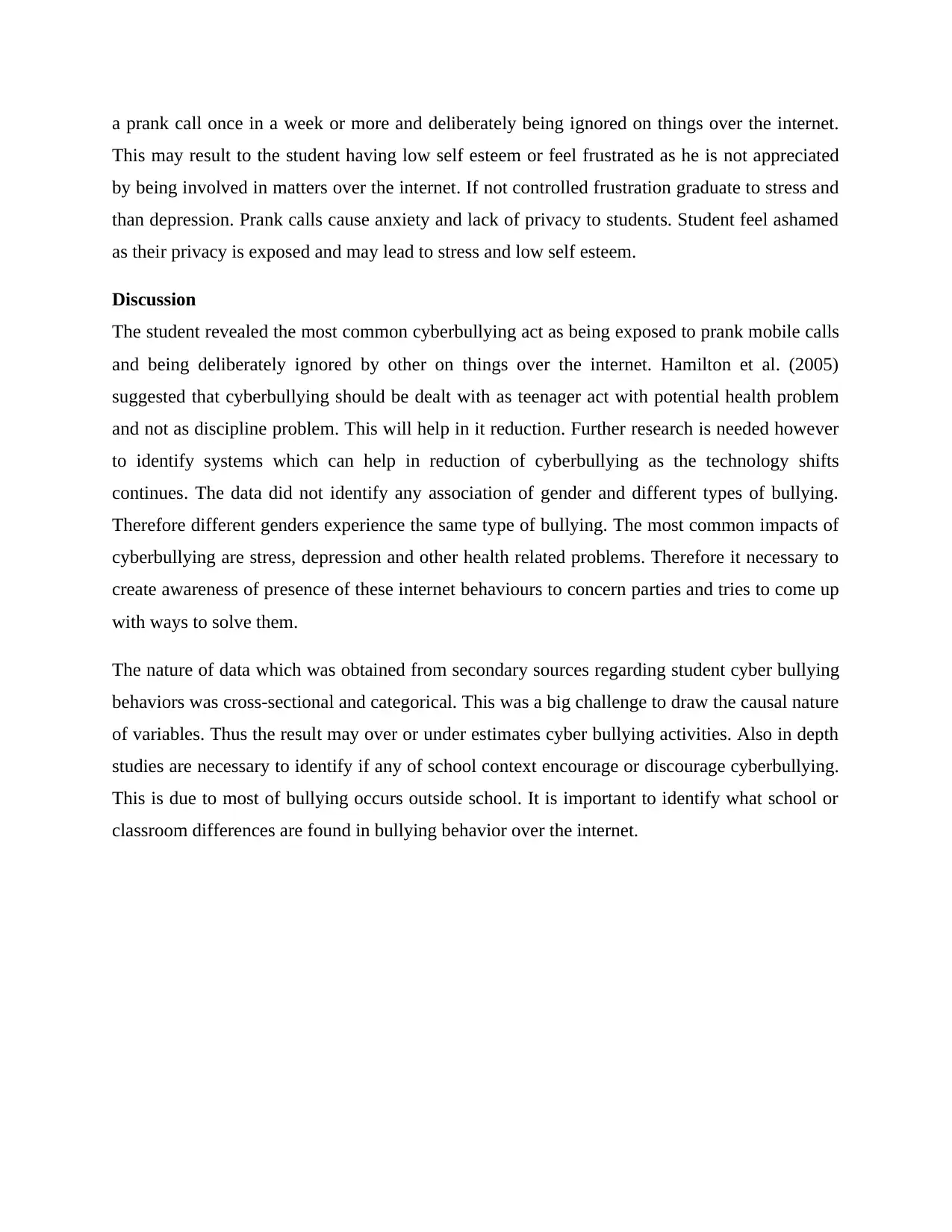
a prank call once in a week or more and deliberately being ignored on things over the internet.
This may result to the student having low self esteem or feel frustrated as he is not appreciated
by being involved in matters over the internet. If not controlled frustration graduate to stress and
than depression. Prank calls cause anxiety and lack of privacy to students. Student feel ashamed
as their privacy is exposed and may lead to stress and low self esteem.
Discussion
The student revealed the most common cyberbullying act as being exposed to prank mobile calls
and being deliberately ignored by other on things over the internet. Hamilton et al. (2005)
suggested that cyberbullying should be dealt with as teenager act with potential health problem
and not as discipline problem. This will help in it reduction. Further research is needed however
to identify systems which can help in reduction of cyberbullying as the technology shifts
continues. The data did not identify any association of gender and different types of bullying.
Therefore different genders experience the same type of bullying. The most common impacts of
cyberbullying are stress, depression and other health related problems. Therefore it necessary to
create awareness of presence of these internet behaviours to concern parties and tries to come up
with ways to solve them.
The nature of data which was obtained from secondary sources regarding student cyber bullying
behaviors was cross-sectional and categorical. This was a big challenge to draw the causal nature
of variables. Thus the result may over or under estimates cyber bullying activities. Also in depth
studies are necessary to identify if any of school context encourage or discourage cyberbullying.
This is due to most of bullying occurs outside school. It is important to identify what school or
classroom differences are found in bullying behavior over the internet.
This may result to the student having low self esteem or feel frustrated as he is not appreciated
by being involved in matters over the internet. If not controlled frustration graduate to stress and
than depression. Prank calls cause anxiety and lack of privacy to students. Student feel ashamed
as their privacy is exposed and may lead to stress and low self esteem.
Discussion
The student revealed the most common cyberbullying act as being exposed to prank mobile calls
and being deliberately ignored by other on things over the internet. Hamilton et al. (2005)
suggested that cyberbullying should be dealt with as teenager act with potential health problem
and not as discipline problem. This will help in it reduction. Further research is needed however
to identify systems which can help in reduction of cyberbullying as the technology shifts
continues. The data did not identify any association of gender and different types of bullying.
Therefore different genders experience the same type of bullying. The most common impacts of
cyberbullying are stress, depression and other health related problems. Therefore it necessary to
create awareness of presence of these internet behaviours to concern parties and tries to come up
with ways to solve them.
The nature of data which was obtained from secondary sources regarding student cyber bullying
behaviors was cross-sectional and categorical. This was a big challenge to draw the causal nature
of variables. Thus the result may over or under estimates cyber bullying activities. Also in depth
studies are necessary to identify if any of school context encourage or discourage cyberbullying.
This is due to most of bullying occurs outside school. It is important to identify what school or
classroom differences are found in bullying behavior over the internet.
Secure Best Marks with AI Grader
Need help grading? Try our AI Grader for instant feedback on your assignments.
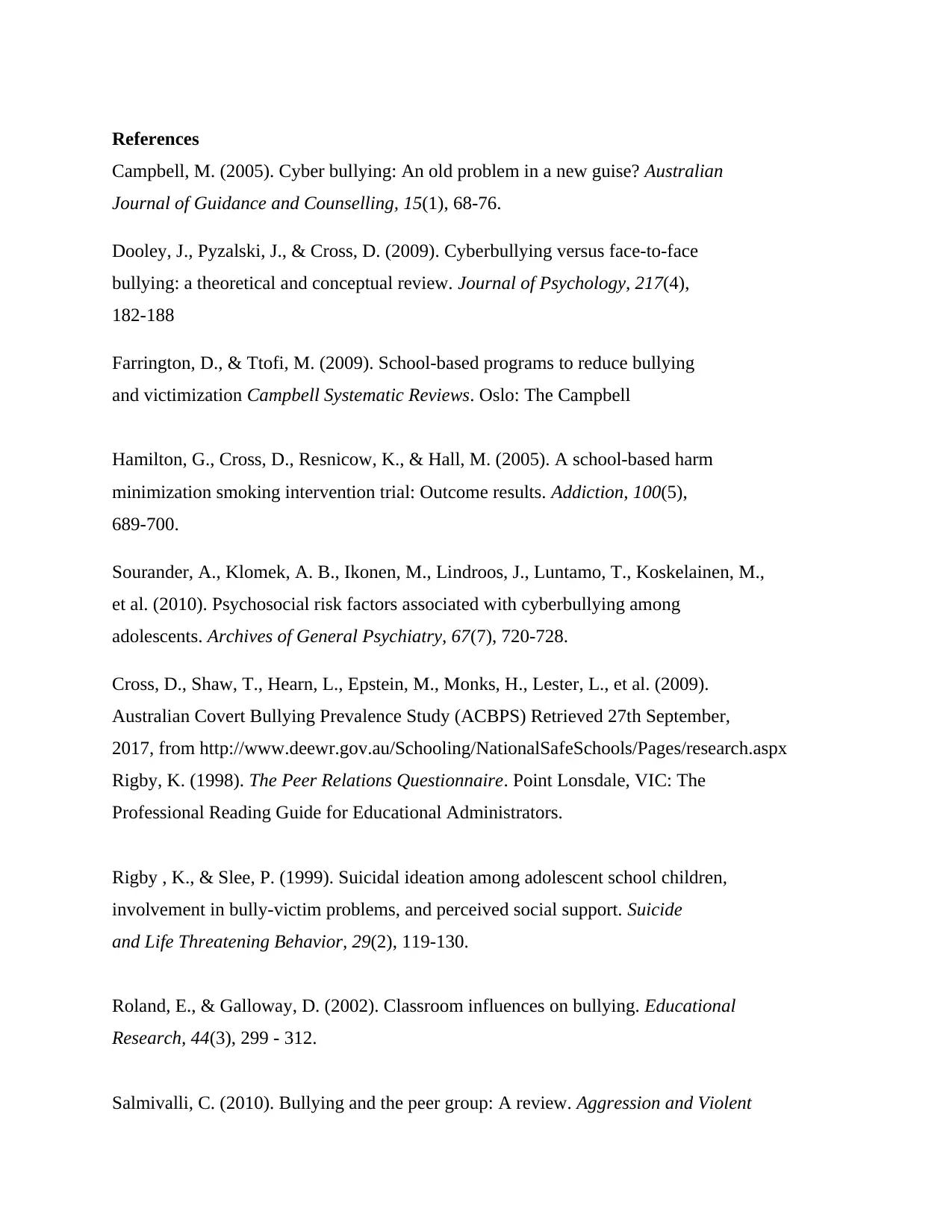
References
Campbell, M. (2005). Cyber bullying: An old problem in a new guise? Australian
Journal of Guidance and Counselling, 15(1), 68-76.
Dooley, J., Pyzalski, J., & Cross, D. (2009). Cyberbullying versus face-to-face
bullying: a theoretical and conceptual review. Journal of Psychology, 217(4),
182-188
Farrington, D., & Ttofi, M. (2009). School-based programs to reduce bullying
and victimization Campbell Systematic Reviews. Oslo: The Campbell
Hamilton, G., Cross, D., Resnicow, K., & Hall, M. (2005). A school-based harm
minimization smoking intervention trial: Outcome results. Addiction, 100(5),
689-700.
Sourander, A., Klomek, A. B., Ikonen, M., Lindroos, J., Luntamo, T., Koskelainen, M.,
et al. (2010). Psychosocial risk factors associated with cyberbullying among
adolescents. Archives of General Psychiatry, 67(7), 720-728.
Cross, D., Shaw, T., Hearn, L., Epstein, M., Monks, H., Lester, L., et al. (2009).
Australian Covert Bullying Prevalence Study (ACBPS) Retrieved 27th September,
2017, from http://www.deewr.gov.au/Schooling/NationalSafeSchools/Pages/research.aspx
Rigby, K. (1998). The Peer Relations Questionnaire. Point Lonsdale, VIC: The
Professional Reading Guide for Educational Administrators.
Rigby , K., & Slee, P. (1999). Suicidal ideation among adolescent school children,
involvement in bully-victim problems, and perceived social support. Suicide
and Life Threatening Behavior, 29(2), 119-130.
Roland, E., & Galloway, D. (2002). Classroom influences on bullying. Educational
Research, 44(3), 299 - 312.
Salmivalli, C. (2010). Bullying and the peer group: A review. Aggression and Violent
Campbell, M. (2005). Cyber bullying: An old problem in a new guise? Australian
Journal of Guidance and Counselling, 15(1), 68-76.
Dooley, J., Pyzalski, J., & Cross, D. (2009). Cyberbullying versus face-to-face
bullying: a theoretical and conceptual review. Journal of Psychology, 217(4),
182-188
Farrington, D., & Ttofi, M. (2009). School-based programs to reduce bullying
and victimization Campbell Systematic Reviews. Oslo: The Campbell
Hamilton, G., Cross, D., Resnicow, K., & Hall, M. (2005). A school-based harm
minimization smoking intervention trial: Outcome results. Addiction, 100(5),
689-700.
Sourander, A., Klomek, A. B., Ikonen, M., Lindroos, J., Luntamo, T., Koskelainen, M.,
et al. (2010). Psychosocial risk factors associated with cyberbullying among
adolescents. Archives of General Psychiatry, 67(7), 720-728.
Cross, D., Shaw, T., Hearn, L., Epstein, M., Monks, H., Lester, L., et al. (2009).
Australian Covert Bullying Prevalence Study (ACBPS) Retrieved 27th September,
2017, from http://www.deewr.gov.au/Schooling/NationalSafeSchools/Pages/research.aspx
Rigby, K. (1998). The Peer Relations Questionnaire. Point Lonsdale, VIC: The
Professional Reading Guide for Educational Administrators.
Rigby , K., & Slee, P. (1999). Suicidal ideation among adolescent school children,
involvement in bully-victim problems, and perceived social support. Suicide
and Life Threatening Behavior, 29(2), 119-130.
Roland, E., & Galloway, D. (2002). Classroom influences on bullying. Educational
Research, 44(3), 299 - 312.
Salmivalli, C. (2010). Bullying and the peer group: A review. Aggression and Violent
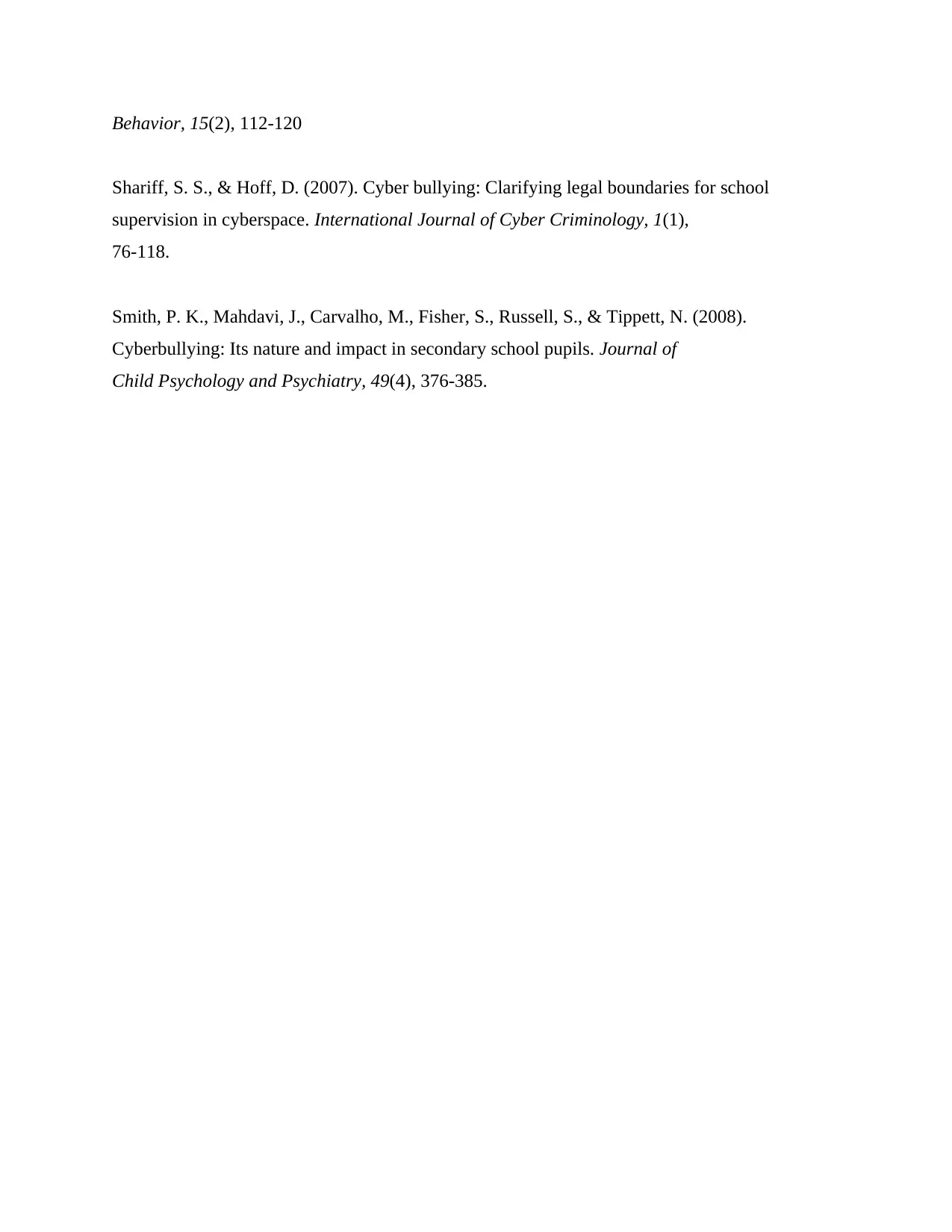
Behavior, 15(2), 112-120
Shariff, S. S., & Hoff, D. (2007). Cyber bullying: Clarifying legal boundaries for school
supervision in cyberspace. International Journal of Cyber Criminology, 1(1),
76-118.
Smith, P. K., Mahdavi, J., Carvalho, M., Fisher, S., Russell, S., & Tippett, N. (2008).
Cyberbullying: Its nature and impact in secondary school pupils. Journal of
Child Psychology and Psychiatry, 49(4), 376-385.
Shariff, S. S., & Hoff, D. (2007). Cyber bullying: Clarifying legal boundaries for school
supervision in cyberspace. International Journal of Cyber Criminology, 1(1),
76-118.
Smith, P. K., Mahdavi, J., Carvalho, M., Fisher, S., Russell, S., & Tippett, N. (2008).
Cyberbullying: Its nature and impact in secondary school pupils. Journal of
Child Psychology and Psychiatry, 49(4), 376-385.

Appendices
Table 1 chi-square of I was sent threatening emails and gender
Chi-Square Tests
Value df Asymp. Sig.
(2-sided)
Pearson Chi-
Square 8.000a 7 .333
Likelihood Ratio 11.090 7 .135
Table 1 chi-square of I was sent threatening emails and gender
Chi-Square Tests
Value df Asymp. Sig.
(2-sided)
Pearson Chi-
Square 8.000a 7 .333
Likelihood Ratio 11.090 7 .135
Paraphrase This Document
Need a fresh take? Get an instant paraphrase of this document with our AI Paraphraser

N of Valid Cases 8
a. 16 cells (100.0%) have expected count less than 5.
The minimum expected count is .50.
Table 2 chi-square of I was sent nasty messages on the internet and gender
Chi-Square Tests
Value df Asymp. Sig.
(2-sided)
Pearson Chi-
Square 8.000a 7 .333
Likelihood Ratio 11.090 7 .135
N of Valid Cases 8
a. 16 cells (100.0%) have expected count less than 5.
The minimum expected count is .50.
Table 3 chi-square of I was sent nasty text messages and gender
Chi-Square Tests
Value df Asymp. Sig.
(2-sided)
a. 16 cells (100.0%) have expected count less than 5.
The minimum expected count is .50.
Table 2 chi-square of I was sent nasty messages on the internet and gender
Chi-Square Tests
Value df Asymp. Sig.
(2-sided)
Pearson Chi-
Square 8.000a 7 .333
Likelihood Ratio 11.090 7 .135
N of Valid Cases 8
a. 16 cells (100.0%) have expected count less than 5.
The minimum expected count is .50.
Table 3 chi-square of I was sent nasty text messages and gender
Chi-Square Tests
Value df Asymp. Sig.
(2-sided)

Pearson Chi-
Square 8.000a 6 .238
Likelihood Ratio 11.090 6 .086
N of Valid Cases 8
a. 14 cells (100.0%) have expected count less than 5.
The minimum expected count is .50.
Table 4 chi-square of I received prank calls on my mobile phone and gender
Chi-Square Tests
Value df Asymp. Sig.
(2-sided)
Pearson Chi-
Square 8.000a 7 .333
Likelihood Ratio 11.090 7 .135
N of Valid Cases 8
a. 16 cells (100.0%) have expected count less than 5.
The minimum expected count is .50.
Table 5 chi-square of i was deliberately ignored or left out of things over the internet and
gender
Square 8.000a 6 .238
Likelihood Ratio 11.090 6 .086
N of Valid Cases 8
a. 14 cells (100.0%) have expected count less than 5.
The minimum expected count is .50.
Table 4 chi-square of I received prank calls on my mobile phone and gender
Chi-Square Tests
Value df Asymp. Sig.
(2-sided)
Pearson Chi-
Square 8.000a 7 .333
Likelihood Ratio 11.090 7 .135
N of Valid Cases 8
a. 16 cells (100.0%) have expected count less than 5.
The minimum expected count is .50.
Table 5 chi-square of i was deliberately ignored or left out of things over the internet and
gender
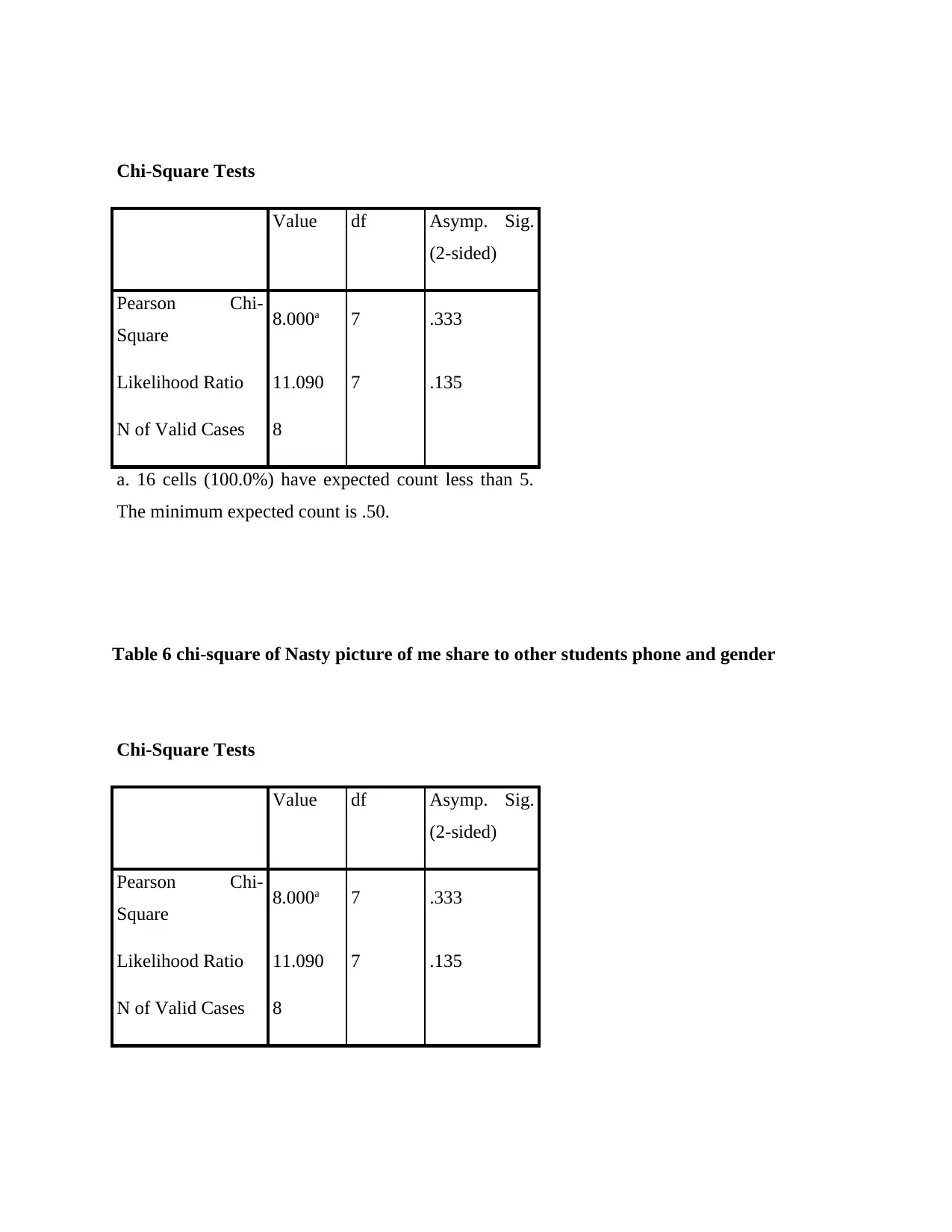
Chi-Square Tests
Value df Asymp. Sig.
(2-sided)
Pearson Chi-
Square 8.000a 7 .333
Likelihood Ratio 11.090 7 .135
N of Valid Cases 8
a. 16 cells (100.0%) have expected count less than 5.
The minimum expected count is .50.
Table 6 chi-square of Nasty picture of me share to other students phone and gender
Chi-Square Tests
Value df Asymp. Sig.
(2-sided)
Pearson Chi-
Square 8.000a 7 .333
Likelihood Ratio 11.090 7 .135
N of Valid Cases 8
Value df Asymp. Sig.
(2-sided)
Pearson Chi-
Square 8.000a 7 .333
Likelihood Ratio 11.090 7 .135
N of Valid Cases 8
a. 16 cells (100.0%) have expected count less than 5.
The minimum expected count is .50.
Table 6 chi-square of Nasty picture of me share to other students phone and gender
Chi-Square Tests
Value df Asymp. Sig.
(2-sided)
Pearson Chi-
Square 8.000a 7 .333
Likelihood Ratio 11.090 7 .135
N of Valid Cases 8
1 out of 16
Related Documents
Your All-in-One AI-Powered Toolkit for Academic Success.
+13062052269
info@desklib.com
Available 24*7 on WhatsApp / Email
![[object Object]](/_next/static/media/star-bottom.7253800d.svg)
Unlock your academic potential
© 2024 | Zucol Services PVT LTD | All rights reserved.





